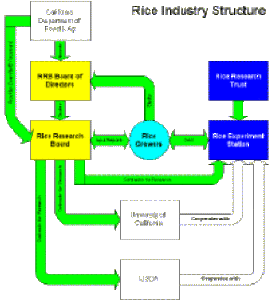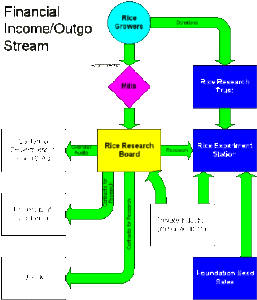Structure and Funding
Mission
The Rice Research Board’s purpose is to help assure the continuing competitiveness and prosperity of the California rice industry by soliciting, evaluating, funding and overseeing research projects and programs that address industry needs.
Structure
The Board is similar to all marketing orders in California. Back in 1969, a group of growers determined that a significant industry need existed to breed new rice varieties. They organized themselves and rallied significant support amongst the rice growing community. A vote was taken and the Rice Research Board was put in place by a vote of the rice producers. This meant that every rice grower was assessed an industry determined amount for the rice they produced. All rice is assessed regardless of variety – either generic or proprietary. Therefore, each grower supports the program on a proportional basis.
The program operates under the authority of the Secretary of Agriculture in the State of California. You can think of the Advisory Boards as a good use of government. The Board operates with the authority of the State of California, this is especially important when it comes to enforcing the law that all producers will contribute to the program. If some one decides that they will not contribute, the State will step in and enforce the law that says they must. But does the State run the Board – no, at least not as a practical matter.
The rice industry elects representatives for an 11 member board of directors. These directors are from the various growing regions of the state and serve as grower contacts for the Board. The Board will meet several times a year and come to decisions on how to spend the assessment money collected. These decisions are technically recommendations to the Director of Food and Agriculture, who has the final say. As a practical matter, the Board makes the decisions that it feels will best benefit the industry, the State reviews the decisions to make sure they are not breaking the rules that the Advisory Boards operate under and the decisions go into effect with a signature from the State. So essentially, the industry collects the assessments, chooses how to spend them and elects directors from amongst its ranks. The State is called in primarily to enforce the law and keep the Board on the straight and narrow. A good, low intervention use of government.
As can be seen in the illustration below, the rice industry works closely with the Rice Experiment Station, the University of California, and USDA. Each of these entities looks at their area of expertise: the RES does the breeding and disease resistance work; UC does our weed control, pest control, varietal testing and other miscellanous work; and USDA explores the post-harvest uses of rice and rice by-products.

Funding
I have already mentioned that the Board collects funds from growers, but with more than 2500 growers in the state, it would be very difficult to collect from each individual. This Board, as does every Advisory Board, looks for a financial constriction point. In this industry, the narrowest point in the chain from producer to buyer is the mills/handlers. There are 13 major and 12 minor mills in the State. The RRB has these mills collect the assessment on behalf of the growers. This makes the entire collection process much simpler.
The current assessment is five cents per 100 pounds of rice produced. The rice is assessed as it comes out of the harvester, hulls and all, in its rough or “paddy” form. Since there was about 3.7 billion pounds of rice produced in the state in 1996, this translates into 1.85 million dollars for the research program per year.

